Xpress-IVE Dialogs
Topics covered in this chapter:
Optimizer Dialog
Accessible by selecting Optimize matrix file... from the Optimizer menu or by clicking the ![]() /
/![]() /
/![]() buttons on the Toolbar.
buttons on the Toolbar.
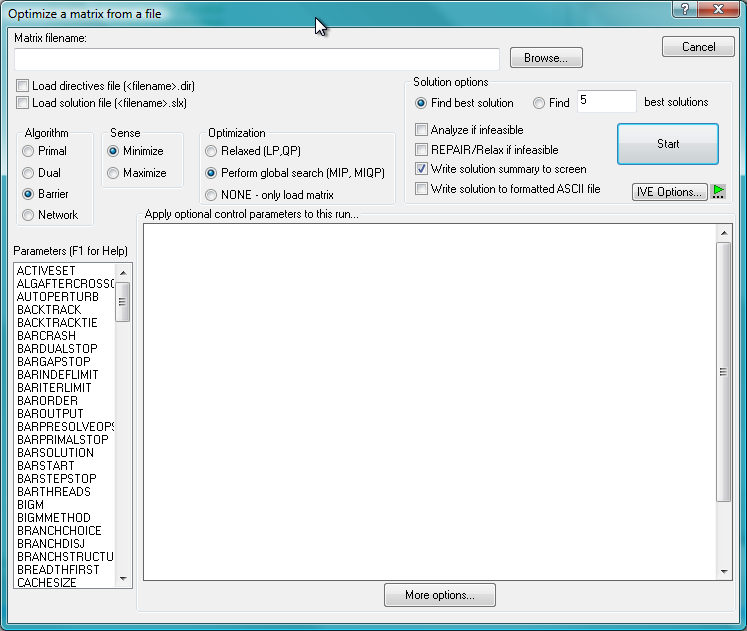
The Optimizer dialog allows the optimization of a matrix file (MPS or LP format). After the various settings have been set, the Start button will proceed with the optimization. Up to five different strategies may be 'checked'. IVE will run the strategies successively and display the progress log in the Output window. To compare the relative performance of different control parameter settings visually, look at the histories of the MIP search graphs.
Options:
Load directives file
Perform the branch and bound search according to an Optimizer 'directives' file. Please check the Optimizer reference manual for more information on directives and how to set them.
Load solution file
Loads an .slx solution file prior to solving an MIP problem. Please check the Optimizer reference manual for more information on .slx solution files.
Algorithm
- Primal
- Simplex primal.
- Dual
- Simplex dual.
- Barrier
- Newton barrier interior point.
- Network
- Network.
Sense
Note that this setting will override the sense specified in the LP file. Make sure the correct sense is selected.
- Minimize
- Minimize the objective function
- Maximize
- Maximize the objective function
Optimization
- Relaxed
- Find a relaxed solution
- Perform global search
- Find integer solutions
- NONE – only load matrix
- Loads the matrix for visualization/inspection. No optimization is performed.
Solution options
- Find best solution
- For MIP problems: runs the Optimizer to find the optimal solution.
- Find N best solutions
- For MIP problems: runs the Optimizer in a special mode to find alternate optimal solutions. (Note that the BB tree visualization will no longer be accurate)
- Analyze if infeasible
- If problem is infeasible, run the IIS Optimizer command to examine infeasibility sets.
- REPAIR/Relax if infeasible
- Attemps to find a feasible solution to an infeasible problem by relaxing constraints and bounds. For more information look up the command REPAIRINFEAS in the Optimizer Reference Manual.
- Write solution summary to screen
- Write nonzero variable values from the solution vector to the Output window in the Run Bar.
- Write solution to formatted ASCII file
- Write the solution to a .prt file and open it for viewing.
Strategies (control parameter settings)
Set these control parameters before the matrix is read in.
For example:
VARSELECTION=3 MIPRELSTOP=0.05
View text Dialog
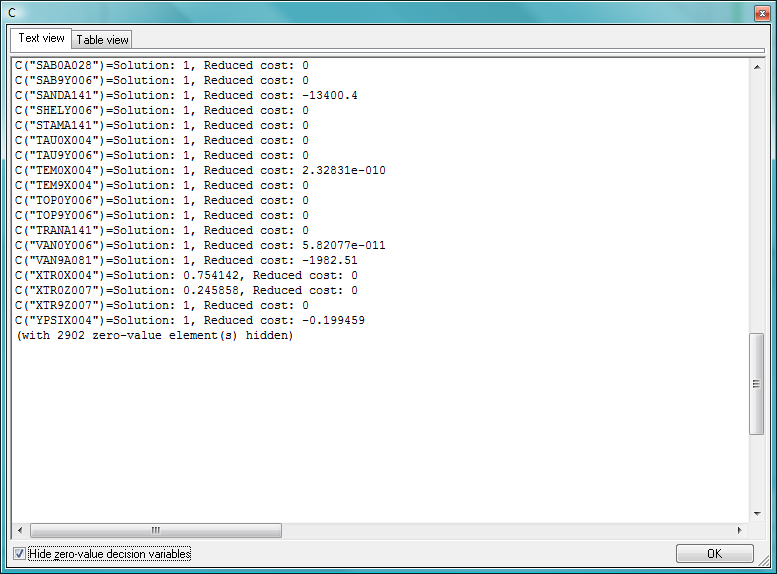
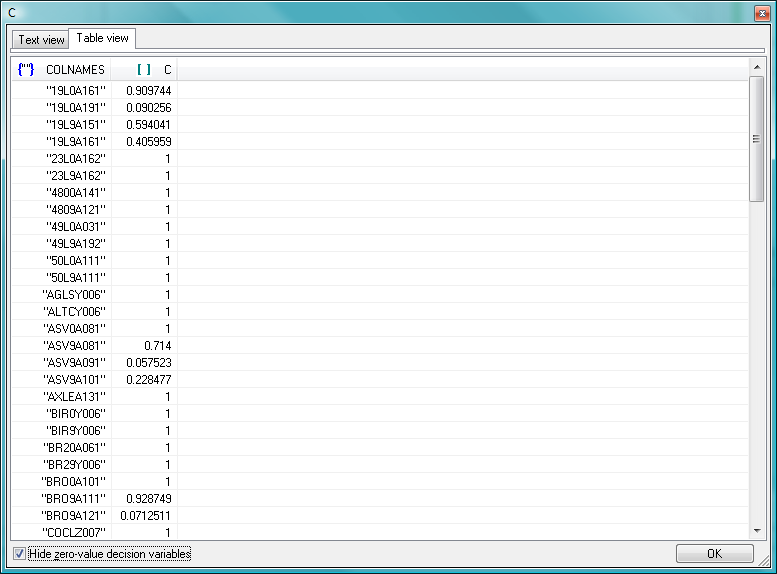
The View text dialog can be used to display in simple editable format:
- The value of an entity in the Entity tree, by double clicking the entity. This is where the full listing of an array or set can be examined.
- The value of an entity in the editor window, by bringing up the context menu and selecting Show value of.... This only applies to non-scalar entities, such as arrays and sets.
- The complete list of ancestors for a node in the branch and bound tree pane in the Run Bar, after double clicking the node.
The contents of either the text view or the table view can be saved (as plain text or as CSV respectively) or copied to the clipboard via the context menu on each control. The text menu further offers facility for full cut-and-paste, and text search.
There is one control to affect display of data: The Hide zero-value decision variables checkbox will, when checked, remove those elements from a collection of mpvar for which the Mosel getsol function returns zero.
Run options Dialog
Accessible by selecting Options... from the Build menu or by clicking the ![]() button on the Toolbar.
button on the Toolbar.
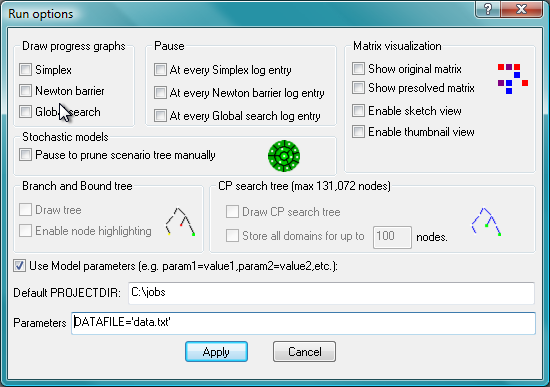
Settings that control the execution of a Mosel model or the optimization of a matrix file can be modified using this dialog. This dialog can be invoked at any time, even while a run is taking place. Changes will take effect immediately after the dialog is dismissed.
Options:
Draw progress graphs
- Simplex
- Graph the progress of the Simplex algorithm. The sampling is made every second.
- Newton barrier
- Graph the progress of the Newton barrier algorithm.
- Global search
- Graph the progress of the global search for integer solutions. The sampling is made every second.
Branch and bound tree
- Draw tree
- Draw the Branch and Bound tree.
- Enable node highlighting
- Allow searching for nodes in the tree by variable name.
Pause
- At every Simplex log entry
- Pause at every log entry during the Simplex algorithm. Log entries are produced periodically during the course of the Simplex algorithm; their frequency is controlled by the "mmxprs" parameter XPRS_LPLOG.
- At every Newton barrier log entry
- Pause at every iteration during the Newton barrier algorithm.
- At every Global search log entry
- Pause at every log entry during the global search for integer solutions. The frequency with which log entries are generated during the global search is controlled by the "mmxprs" parameter XPRS_MIPLOG.
Matrix Visualization
- Show original matrix
- After a problem is loaded in the Optimizer, its matrix can be examined. Select this option to make a copy of the matrix and visualize it.
- Show presolved matrix
- After a problem is 'presolved' by the Optimizer, the matrix will most likely have changed. Select this option to examine the presolved matrix.
Stochastic models
(if available)
- Pause to prune scenario tree manually
- When developing a stochastic model, use this option to pause the Mosel run just before solving the stochastic problem. When the model is paused, scenarios can be aggregated or deleted in the scenario tree.
Constraint programming models
(if available)
- Draw CP search tree
- Draw the CP search tree.
- Store all domains for up to nnnn nodes
- Maintains detailed variable domain information for the first nnnn nodes.
Use Model parameters
If the Mosel model has declared one or more parameters, they can be overriden. Select this option and then specify the parameter values to be used during the execution. Any number of parameters may be omitted: only those specified will modify the default parameter values.
Default PROJECTDIR
If a Project is loaded, this will be set by default to the directory in which the Project is located.
Parameters
A sequence of assignments, in name=value, name2=value... format, specifying names and values to be passed to the parameters ... end-parameters block of a Mosel model when it runs.
Debug options Dialog
Accessible by selecting Debug Options... from the Debug menu or by clicking the ![]() button on the Toolbar.
button on the Toolbar.
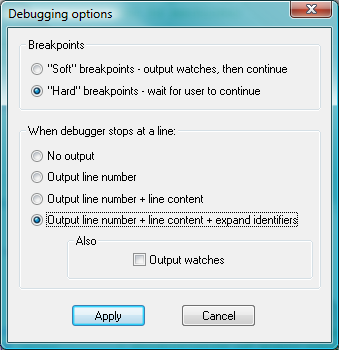
This dialog contains settings that control the behavior of the debugger.
Options:
Breakpoints
- "Soft" breakpoints
- When reaching a soft breakpoint, perform any of the actions below and then continue. This helps in gathering a log of the model execution without user intervention.
- "Hard" breakpoints
- When reaching a hard breakpoint, watches are updated and the execution stops. The execution must be resumed manually.
When debugger stops
The following options are available:
No Output
Output line number
Output line number + line content
Output line number + line content + expand identifiers
Output watches
See some typical debugger output for more information.
Breakpoint condition Dialog
Accessible by selecting Set/Remove Breakpoint condition... from the Debug menu or by clicking the ![]() button on the Toolbar.
button on the Toolbar.
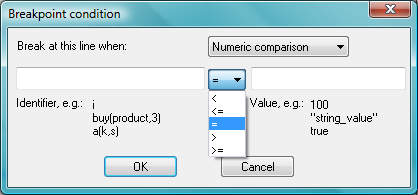
This dialog allows setting a conditional breakpoint.
The conditional breakpoint will activate only when the condition is met.
Export to matrix Dialog
Accessible by selecting Export Matrix... from the Build menu or by clicking the ![]() button on the Toolbar.
button on the Toolbar.
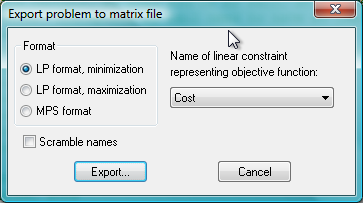
After the Mosel run completes successfully, a standard matrix file (MPS or LP) can be exported using this dialog.
The objective function in the matrix file is determined by the linear constraint entity specified. Consequently, the objective must have been declared as a linear constraint variable in the Mosel model.
The column and row names can be scrambled to hide the original entity names from the model.
Deploy Dialog
Accessible by selecting Deploy... from the Deploy menu or by clicking the ![]() button on the Toolbar.
button on the Toolbar.
If you wish to build a model as an executable file, see the Self Executing Model Dialog.
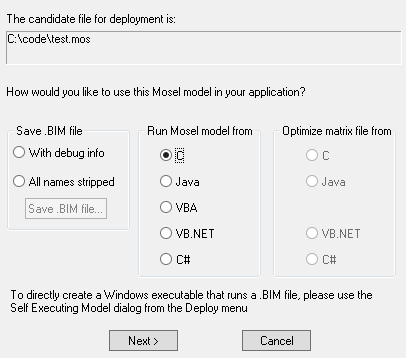
This dialog is the first step in deploying a mosel model or a matrix file in a user application written in C/C++, Java or VB. After selecting how the current file will be deployed, click on "Next >" to preview and save the generated code.
Choices:- Save .BIM file (with debug information)
- The .BIM file will contain all original strings plus debug information.
- Save .BIM file (all names stripped)
- Secure the .BIM file by removing human-readable identifier names.
- Run Mosel model from C
- Only available when a .mos file is open in the editor. Produces a simple C program.
- Run Mosel model from Java
- Only available when a .mos file is open in the editor. Produces a simple Java program.
- Run Mosel model from VBA
- Only available when a .mos file is open in the editor. Produces a simple VBA program.
- Run Mosel model from VB.NET
- Only available when a .mos file is open in the editor. Produces a simple VB.NET program.
- Run Mosel model from C#
- Only available when a .mos file is open in the editor. Produces a simple C# program.
- Optimize matrix file from C
- Only available when a matrix file is open in the editor. Produces a simple C program.
- Optimize matrix file from Java
- Only available when a matrix file is open in the editor. Produces a simple Java program.
- Optimize matrix file from VB.NET
- Only available when a matrix file is open in the editor. Produces a simple VB.NET program.
- Optimize matrix file from C#
- Only available when a matrix file is open in the editor. Produces a simple C# program.
Self-Executing Model Dialog
Accessible by selecting Self-Executing Model... from the Deploy menu or by clicking the ![]() button on the Toolbar.
button on the Toolbar.
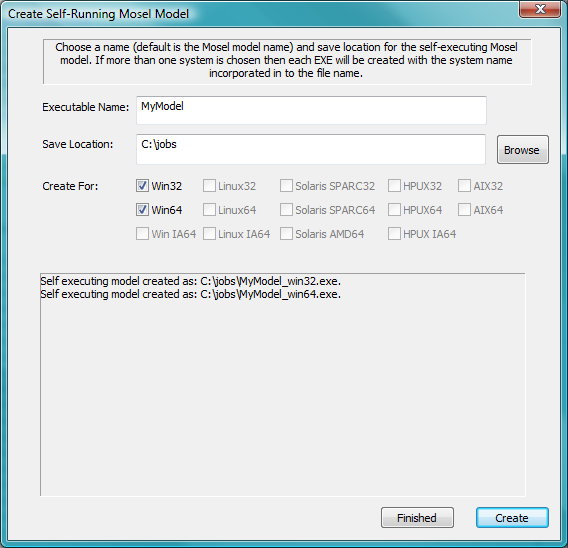
This dialog can be used to create executables with self-contained compiled Mosel models within them.
The dialog contains the following options:
- Executable Name: The name of the executable to create. The file used to create the self-running model will be the Mosel file currently in focus in the editor. Executables are created using a concatenation of this name and the platform.
- Save Location: The folder location to attempt to save any created executables to.
- Create For: Any platforms for which IVE finds suitable executable stubs for will be selectable. New executable stubs will be added over time and should be available from the Xpress website. Currently there are only Windows stubs available. Any stub executables (named SelfRunMosel_platform.exe) should be placed in the "%XPRESSDIR%\bin\Tools_SRAssist" folder.
- Message Output: Any error messages or notifications concerning the executable creation are displayed here.
- Finished: Exit the dialog.
- Create: Click this to have IVE attempt to build and create the executable for the selected platforms.
List Modules Dialog
Accessible by selecting List available modules... from the Modules menu or by clicking the ![]() button on the Toolbar.
button on the Toolbar.
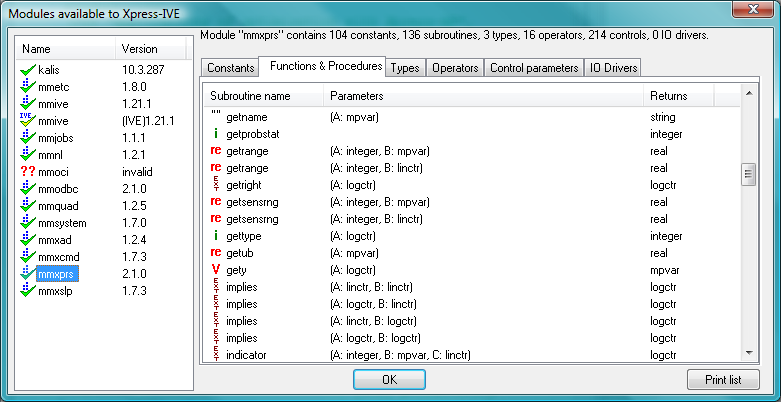
Lists the contents (constants, subroutines, operators, types and control parameters) of Mosel dynamic modules that are currently available to Mosel. Please refer to the Mosel documentation for more information on what modules are.
- Select a module name from the list on the left and then browse through its contents using the tabs on the right.
- A green check next to a module name indicate that it was successfully loaded by Mosel.
- A green check with a Dash Optimization logo indicates a module which is part of the Xpress package.
- Two red question marks next to a module name indicate that even though a .dso file exists, it could not be loaded by Mosel.
New Module Wizard Dialog
Accessible by selecting Create a new module... from the Modules menu or by clicking the ![]() button on the Toolbar.
button on the Toolbar.
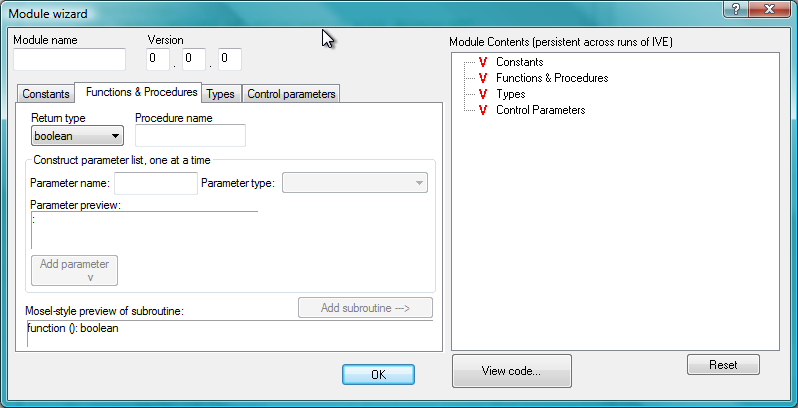
Edit the contents of a virtual .dso module (constants, subroutines, types and control parameters), then generate the template source code for producing the module.
- Name the module and specify version numbers.
- Add some constants:
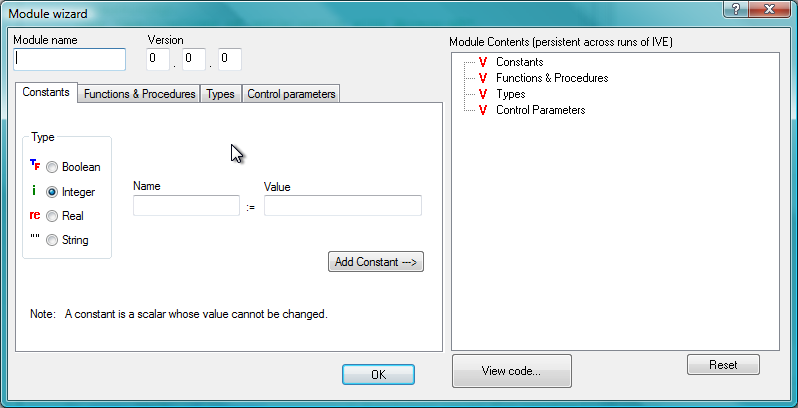
- Add some subroutines:
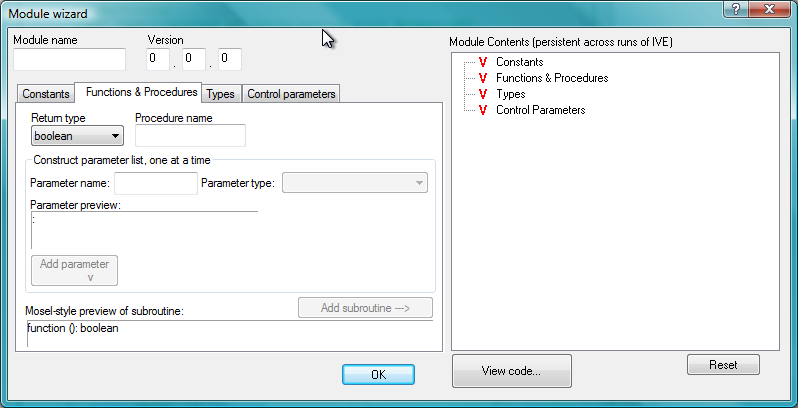
- Add some types:
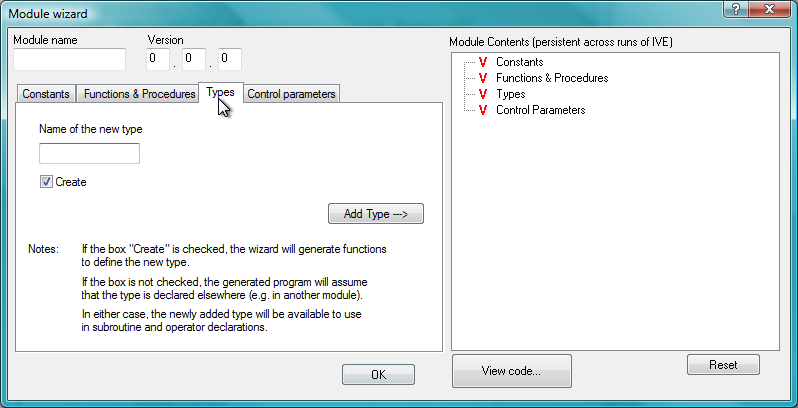
- Add some control parameters:
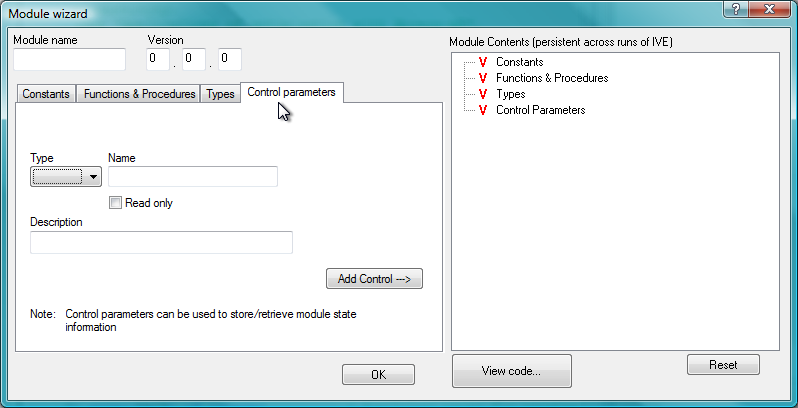
- At any time, clicking on View code... will show the Source code dialog with the code generated for the current contents of the module.
- When satisfied with the contents of the module, save the code that is produced and fill in the functionality.
Source code Dialog
Shown after completing the steps required by the Deploy or the New Module Wizard dialogs.
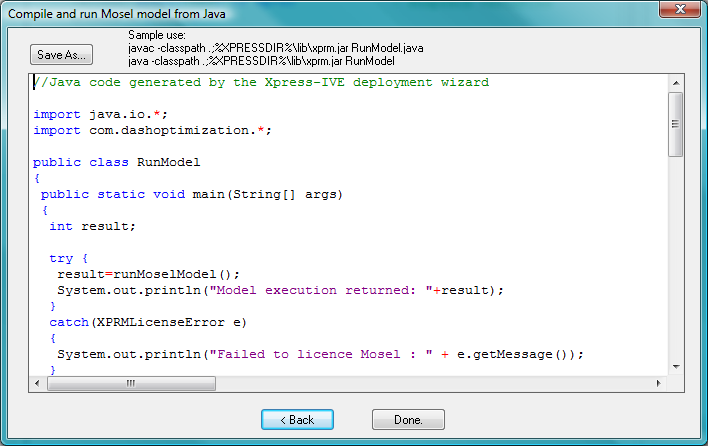
This dialog is the last step in any Xpress-IVE operation that produces C, Java, VB, VB.NET or C# source code. Depending on what type of source code was produced, compilation instructions are given. Save the contents of the editor using the Save As... button.
© 2001-2024 Fair Isaac Corporation. All rights reserved. This documentation is the property of Fair Isaac Corporation (“FICO”). Receipt or possession of this documentation does not convey rights to disclose, reproduce, make derivative works, use, or allow others to use it except solely for internal evaluation purposes to determine whether to purchase a license to the software described in this documentation, or as otherwise set forth in a written software license agreement between you and FICO (or a FICO affiliate). Use of this documentation and the software described in it must conform strictly to the foregoing permitted uses, and no other use is permitted.

